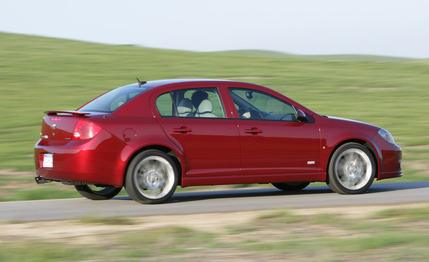 Short Take Road Test
Short Take Road Test
Chevrolet’s small cars have been so consistently dreary—when was the Vega introduced?—that it’s hard not to greet the arrival of a new one the way we start each Detroit Lions football season: just waiting for the faults to appear and the excuses to start.
News flash: The turbocharged Cobalt SS is good. Not just not bad, but genuinely good. We took a coupe down to Virginia for our annual Lightning Lap track fest, and it dominated its class, setting a new front-drive record and lapping VIR’s 4.2-mile Grand Course more quickly than a Subaru WRX or Mitsubishi Evolution MR, not to mention plenty of higher-pedigreed and far pricier machinery, including a Honda S2000 CR and the 416-hp Lexus IS F. And now the SS is available with four doors.
Like the coupe, the Cobalt SS sedan is blessed with a 2.0-liter, direct-injection, turbocharged four-cylinder stirring up 260 horsepower and 260 pound-feet of torque. A five-speed manual is the only transmission available. All the SS extras that come with the coupe are included on the sedan, meaning the same suspension treatment, the same Brembo front brakes, and the same body mods.
Familiar Recipe, Familiar Results
And just like the coupe, the SS sedan works remarkably well. GM is not known for small-car excellence, but if it keeps this up, it will be. A stable 0.92 g on the skidpad is outstanding for this class. At the limit, the Cobalt remains responsive and easily controlled, without sacrificing comfort and confidence on uneven roads the way the Mazdaspeed 3 does. With such excellent wheel and body control, the ride-and-handling balance demonstrates a level of expertise—dare we say passion?—Chevrolet has heretofore only achieved with the Corvette.
Primary-control feel, too, is class leading. Often, the words “speed-sensitive electric power steering” on a spec sheet mean feedback as clear as Charlie Brown gets from his teacher, but not so in the Cobalt. The steering is tight, quick, and pretty chatty. The brake pedal is easy to modulate, and the binders haul the Cobalt down from 70 mph in 163 feet—two feet longer than the last Evo we tested.
Compared with competitors like the Evo, though, the Cobalt suffers from two fewer driven wheels. The resulting traction deficit hampers launches, but the SS manages 0 to 60 mph in 5.5 seconds and the quarter-mile in 14.2 at 102 mph. Like the coupe and the manual-equipped HHR SS, the sedan has Chevrolet’s nifty launch control and no-lift shift features. The former holds rpm steady for a clutch-dumping takeoff, and the latter allows you to keep your right foot planted during shifts for a satisfying pop from the tailpipe and minimized turbo lag on clutch reengagement. In every measurable performance category, the Cobalt SS sedan is dead even with the coupe—not surprising considering the two cars are nearly identical dimensionally and the sedan only weighs about 40 more pounds. More important, the SS is competitive with other turbocharged four-doors. Pricing for the coupe or sedan version of the Cobalt SS starts at $24,095, and the sedan’s back seat is actually usable although still smaller and less comfortable than that of the Mazdaspeed 3 or VW GTI.
Quality Is Job 847. Perhaps It Should Be Promoted?
As mighty as the Cobalt SS’s performance might be, it still springs from the lowly Cobalt, so those who overlook the unique fascia and the SS-specific wheels will still see a rental special, and the interior is constructed primarily of plastics cheap enough to be rejected from a Chinese toy factory; the Tata Nano probably has a fancier parking-brake lever. It’s offensive to think Chevrolet can do no better. And our taller drivers report that the SS desperately needs a telescoping steering wheel, an item several in this class include as standard equipment but one that the Cobalt doesn’t even offer as an option.
But these complaints pale in comparison to the SS’s dynamic purity and genuine sporting abilities. The Cobalt is due for replacement by the new Cruze in 2010, and if Chevrolet can incorporate a chassis this cooperative into the more desirable body and classier trimmings of the Cruze, we’ll again find ourselves in the unfamiliar position of championing a small Chevy. Something needs to lift the spirits of Detroit, and it’s not likely to be our football team.